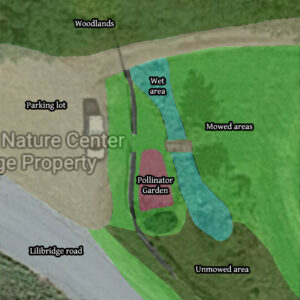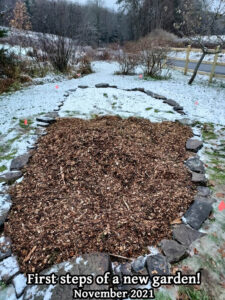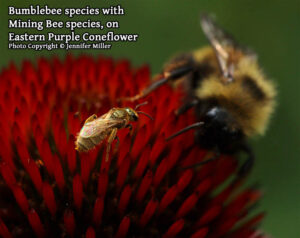Where Science, Art and Nature Come Together.
Lilibridge Native Plant Garden
An exciting new installation at the Lilibridge Preserve! For 2022, we are planning a wonderful new garden near the parking lot.
Timeline and updates:
– Autumn 2021: volunteers have prepared the location of the garden with cardboard, wood chips, and rocks to line the edges. Layering cardboard with mulch on top, plus winter conditions, will help prepare this site without the need for digging.
– Winter 2021-Spring 2022: Volunteers have started hundreds of seeds at home, to transplant into the garden! The seeds that will become this garden are sleeping, but soon spring will arrive and they will begin wake up!
In its first year, the garden will admittedly not look like too much. Many native plants are long-lived, but slow to get started. In their first year, they put a lot of energy into growing root networks. Seedlings are currently being started by volunteers and will be planted into this garden from May-July. The first year the plants sleep, the second year they will creep, and the third year they will leap! While we will have some blooms in 2022, look to 2023 for things to really get beautiful!
Why create such a garden in an area that is already full of natural beauty? The sad reality is that even our most protected natural areas are often altered, sometimes in hidden ways, by the changes brought by settlers to North America; in addition to pressures from invasive species, habitat fragmentation, and biodiversity loss. We would love to enrich our already wonderful property, to increase bio-diverse habitat for all our native species!
“Pollinator Garden” does not quite fit the description here. While the species selected for our future garden do indeed support a huge number of pollinators, the garden goes beyond that to support many other species!
How beneficial is it to use plants native to Western NY? Let us name the ways…
Host Plants: Besides beautiful blooms, native flowers provide vital host material to many species of insects. Insects, famously caterpillars for butterflies and moths, often have special relationships with their host plant. A host plant is the plant that evolved alongside an animal species, to the point where at least one is dependent upon the other. One that most know is the monarch butterfly; if a monarch cannot find a native milkweed species to lay its eggs on, there is no hope for the next generation. And so, for many species, the flowers do provide important food for adult butterflies, but if they cannot find the correct species of vegetation for their caterpillars, the flowers are doing little good. This is why it was vital for us to select native species, as those best support our native insects.
Food For Birds: Did you know that almost all baby birds depend on high protein diet for their first stages of life? Studies have shown that invertebrates (insects, spiders; especially caterpillars) are vital for most breeding birds to raise young. A single nest of chickadees may require over 7,000 caterpillars per year! Habitat that hosts native insects on native plants is vital for birds to raise young. Additionally, the seeds from native plants are nature’s bird feeder! Our native birds that overwinter here in Western NY depend on natural food sources. The mowing, and clearing of native flower seed heads, and removal of thickets with berry-bearing native bushes and trees has greatly reduced the options of our overwintering birds. But, we can help, by adding native plants for them, and not removing the dead seed heads. Nothing beats seeing a flock of winter birds descend into a field, thicket, or garden, to feast on the dead seed-heads of native plants. They evolved to eat these seeds and you can tell! It is great fun to see!
And Yes, Pollinators: Of course we love to see the flash of butterfly wings, and the lively hum of bumblebees on the flowers! Yes, bees- we have over 4,000 species of bee native to the USA, and over 400 in NY alone! And great news if you are feeling nervous… you are very unlikely to be stung by any of them. Many are stingless, too small to sting you, or just don’t want to. Bees are most aggressive in colonies- such as non-native honeybees- and almost none of our native bees form colonies. Most of our bees are solitary in nature! You have little to fear from our native bees! Our native bees need all the help they can get. Many species are in severe decline, and several of our bumblebees are now endangered.
Do you want to learn more about how to get native plants in your gardens at home? Stay tuned for our upcoming programs on this topic! There are also many free resources online to help you get started. Pfeiffer Nature Center is not associated in any way with these groups, but the author can suggest them as a starting point if you’d like to learn more!
NWF’s native plant finder: https://www.nwf.org/nativeplantfinder/plants The National Wildlife Federation’s online tool to search for what species are native to your region, by ZIP code. This can be useful if you don’t know where to start!
Audubon’s native plant finder: https://www.audubon.org/native-plants A similar tool from Audubon, search via ZIP code. You can also enter your email to get an emailed result, but entering your email is not required to search. Useful for learning which birds might benefit, also.
Sources for Native Plants via the Finger Lakes Native Plant Society: https://flnps.org/links#SourcesforNativePlantsintheFingerLakesRegionofNY Scroll down for a listing of plant nurseries that sell native plants in Western/Central NY.
NY Flora Atlas: https://newyork.plantatlas.usf.edu/ A bit more advanced, but a useful and educational tool for learning more about our native plants! Easy to look at a listing of plants based on your county. Just click your county on the map.
Biota Of North America Program (BONAP): http://bonap.org/ Maps that show, on the county level, the records of native and non-native plant species. Hint: this is easiest to use if you know the scientific name of a plant. Try searching google for “ _plant species_ BONAP”, where you replace _plant species_ with the plant name.
Interested in easily starting native seeds at home over the winter, outdoors? It can be as simple as saving some items from your recycling bin. See our Winter Sewing article for more information!




